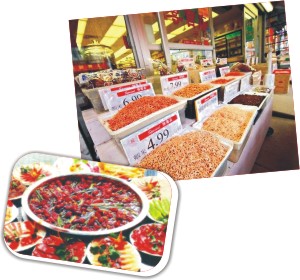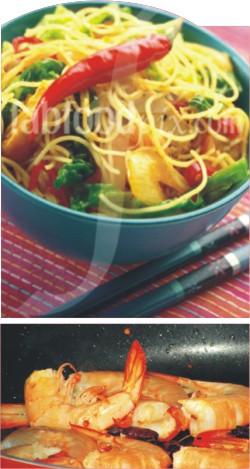Distant Diary
Live from China:
Chinese Food
Dr. Salehuddin Ahmed
 IT is our sixth month in Beijing. During this period, we have tasted all kinds of Chinese food. We have fallen in love with the wonderful dishes of 'original' Chinese cuisine. I say 'original' because so far what we have been eating outside China, in Bangladesh, US, UK, India and other countries, as Chinese food, is not really Chinese. Each country's Chinese food has its own blending. In Bangladesh for example, we eat Bangladeshi version of Chinese food. One of the good past times of Bangladeshis is to have Chinese food. Here in China, the taste, cooking, presentation etc. are very different and in every region they have different cuisine. For instance, Sichuan dishes are quite spicy, they use lot of chilies, especially red, the ones we call 'shukna morich'. Xinjiang province has excellent meat dishes including all kinds of Kababs. Then Tibet has the best dumplings with Yak meat. IT is our sixth month in Beijing. During this period, we have tasted all kinds of Chinese food. We have fallen in love with the wonderful dishes of 'original' Chinese cuisine. I say 'original' because so far what we have been eating outside China, in Bangladesh, US, UK, India and other countries, as Chinese food, is not really Chinese. Each country's Chinese food has its own blending. In Bangladesh for example, we eat Bangladeshi version of Chinese food. One of the good past times of Bangladeshis is to have Chinese food. Here in China, the taste, cooking, presentation etc. are very different and in every region they have different cuisine. For instance, Sichuan dishes are quite spicy, they use lot of chilies, especially red, the ones we call 'shukna morich'. Xinjiang province has excellent meat dishes including all kinds of Kababs. Then Tibet has the best dumplings with Yak meat.
I have been collecting information on Chinese food and thought of sharing with you my 'little' knowledge about it. It is hard to know the details of Chinese cuisine, but this may help you understand the basics. The different types of food Chinese eat are rice, noodles, vegetables, eggs, fish, Doufu (in English 'Tofu', meaning bean curd), meat and poultry, soup, hotpot, Beijing roast duck etc.
Rice
China has been the earliest centres of rice cultivation and they are the largest growers of rice in the world. Chinese people cannot do without rice. It is their staple and eats rice in every meal. People here like boiled or steamed rice. There are varieties of rice dishes in China. One of the most popular dishes is the fried rice, not only in China but also in other parts of the world. Such different varieties of fried rice depends on the types of ingredients added to the rice, such as beans, chopped meat, vegetables, eggs etc. The Chinese love eating congee as breakfast. In Beijing we have eaten in specialized congee restaurants. One such restaurants is interestingly named "100 Congees". They do serve a
wide variety of congee.
Noodles
Noodles are also a staple food for the Chinese. People use different and simple methods of cooking noodles. As per people's likes and tastes, various ingredients and materials are added. So noodle dishes can be very varied and taste very different.
Chinese noodles are of various width and length. They can be as thin as needles or thick as chopsticks. They are usually served long and uncut. This is because long noodles are a symbol of longevity in Chinese tradition. Thus, during birthday celebrations, people will serve "longevity noodles" in good hope for longevity. As there are different ways of preparing noodles using materials and ingredients, over a thousand varieties of noodle dishes exist in China. Some of the famous ones are : soy bean paste noodles (or Zhejian Mian) in Beijing, hand-pulled noodles (or Lamian) in Shaanxi Province, sliced noodles (or Daoxiao Mian) in Shanxi province, dandan noodles (or dandan mian) in Sichuan Province, to just name a few. "Mian" in Chinese means noodles. Noodles are usually served and eaten hot or cold, boiled, steamed, stir-fried, deep-fried or served in soup.
Before eating, you have to stir and mingle using the chopstick or a fork and will enjoy the taste.
Fish
One of the favourite foods in China is Fish. Fish is an indispensable dish during festivals and celebration and an essential one in family dinners. For the Chinese fish is very important, because they consider fish as a symbol of abundance and prosperity. In Chinese the pronunciation of fish, "yu", sounds the same as with the word for abundance, richness or surpluses and it is believed that eating fish will bring prosperity in the coming year. Popular fish and shelfish include, carp, grass carp, crucian, sea bass, squid, soft-shell turtle, crab, shrimp, prawn, scallops, oysters etc.
We have tasted different fish dishes in Beijing restaurants. One of the best dishes is the steamed fish. It is so delicious. When you visit Beijing, do not forget to take this dish.
Doufu
Doufu (we know it as Tofu) has its origin in China. It is made from soy milk, water and a curd agent. Doufu is prepared the same way as cheese and contains little fat, and is high in protein, calcium and iron. Doufu itself does not have much flavor or smell, but it can absorb new flavours through spices and marinades.
 Soup Soup
Chinese people historically eat soups of all kinds. It is part of Chinese food culture for a very long time and is considered as one of the most nutritious and digestible food types. In cooking soup particular attention is attached to the soup stocks. Meat, bones, eggs, marine products, vegetables, fruits, crops, edible fungus and mushrooms are widely used.
Chinese soup can be basically characterized in two main categories, thin or thick. Thin soup is made with clear broth and cooked quickly, whereas thick soup is cooked more slowly with all the stocks added together and often starches are used as thickener.
Huo guo (hotpot)
'Huo' in Chinese means fire and 'guo' means pot or pan. Huoguo is very popular in China. There are special restaurants which serve only huoguo. It is fascinating how they prepare and serve huoguo. In bigger restaurants, the waiter will bring you a menu and then put a pot with the stock water on a burner on the table. Sometimes you may have individual smaller pots. In the menu you will find many varieties of raw food items, i.e., all kinds of meats, vegetables, fishes, fish balls, meat balls, mushrooms etc. You choose and order. You put the sticks inside the pot and start eating when ready. Then the waiter will charge you as per the number of sticks you have used. It is like the conveyor belt sushi bars in Japan !
Regional Cuisines
China can be divided into many geographical areas. Each area has a distinct style of cooking. The ingredients used in the food are based on the agricultural products produced in the region. In the northern part of China, for example, wheat is more eaten than rice as staple food. Food using wheat as its main ingredients such as noodles and dumplings are widely available. As for vegetables, cabbage is ubiquitous. China's southern cuisine is famous for its exceptional tastiness and variety. Outside China restaurants serve mostly similar Southern China dishes.
That is what I have learned about Chinese cuisine and food. In Beijing, being the capital of the country, there are numerous restaurants and hotels all over the city. The city of Beijing has more than 70 five-star hotels. In those restaurants and hotels, you will find food from all over the world, just name it. They also serve food from all the regions of China. I am sure after reading this write-up, many will be interested to visit China and have 'original' Chinese food. Safe journey to China.
(Chief Technical Advisor, International Poverty Reduction Centre in China (IPRCC) Beijing.)
|
